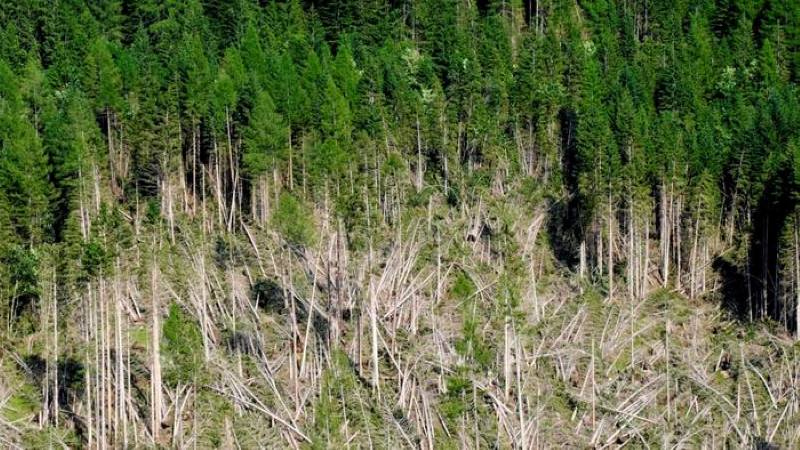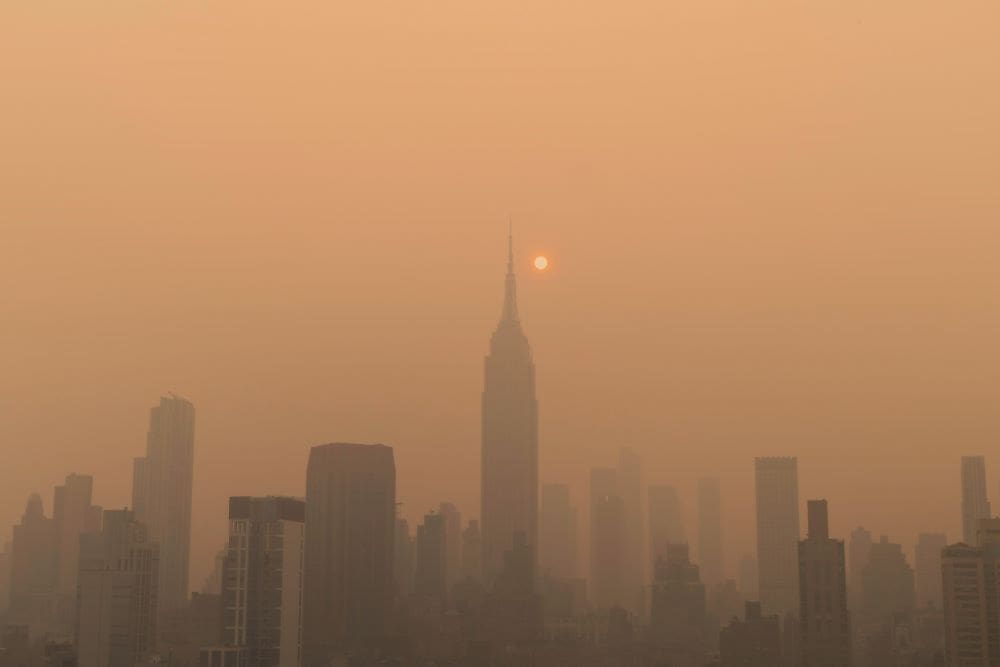Explore the latest insights from top science journals in the Muser Press daily roundup (September 19, 2025), featuring impactful research on climate change challenges.
In brief:
The economic cost of climate change for Europe’s Forests – Need for strategic adjustments
Forest disturbances regularly cause damages worth millions. The wood price then decreases rapidly due to large amounts of damaged timber or the wood is so badly damaged that it cannot be sold at all. Timber may suddenly flood the market in large volumes or be so badly damaged it can no longer be sold. For the first time, a team led by Rupert Seidl, Professor of Ecosystem Dynamics and Forest Management, Thomas Knoke, Professor of Forest Management, and PhD-Student Johannes Sonnweber Mohr has calculated how climate change could affect the economic value of Europe’s forests.
The study, recently published in Nature Climate Change, examines the expected climate scenarios for the end of the century. Using computer models, the team simulated how Europe’s forests might grow under different climate conditions and how wildfires, storms, and bark beetle could shape forest development and timber harvests.

Gains in Northern Europe, losses in Central and Southern Europe
The study shows that global warming will bring varied – and sometimes opposing-effects. “With ongoing climate change, large-scale disturbances will become more frequent, and costs for forest owners will rise,” says Rupert Seidl. “While damages across Europe amounted to around €115 billion during the reference period from 1981 to 2005, all our scenarios show an significant increase. Under 4.8 degrees of warming, costs could climb as high as €247 billion.”
At the same time, longer growing seasons, higher temperatures, and rising atmospheric CO₂ concentrations could accelerate tree growth in some regions, putting timber on the market more quickly. The result: not only higher costs from disturbances but also higher revenues at the European level overall.
However, these gains are unevenly distributed. In Southern Europe, damages exceed additional revenues under every scenario. In Central Europe – including Germany, Austria, and the Czech Republic – the value of forests declines sharply even at moderate warming of 2.6 degrees, leaving possible increased production barely able to offset losses. In contrast, Scandinavian forests are less often hit by disturbances and benefit the most from changing conditions. There, productivity gains could even outweigh the costs.
“Forestry can no longer follow a one-size-fits-all approach”
“Modeling always focuses on selected aspects,” explains first author Johannes Sonnweber Mohr, a researcher at the Chair of Ecosystem Dynamics and Forest Management. “We concentrated on the three most common disturbance types today, but new ones may emerge. What we see overall is that uncertainties for the future are rising sharply. Forestry can no longer follow a one-size-fits-all approach – it’s becoming less and less predictable. Using these insights to adapt forest management to climate change could reduce economic losses while fostering more climate-resilient forests with high ecological value.”
According to the researchers, careful economic evaluation is key to effective adaptation. “By comparing simulations with and without disturbances, we can directly quantify their financial impact on forest owners,” says Thomas Knoke. “This also highlights the advantages of structurally diverse mixed forests. While they are often seen as less profitable than conifer-dominated forests, their lower susceptibility to disturbances could make them much more valuable in the future than they might appear today.”
Journal Reference:
Mohr, J.S., Bastit, F., Grünig, M. et al., ‘Rising cost of disturbances for forestry in Europe under climate change’, Nature Climate Change (2025). DOI: 10.1038/s41558-025-02408-9
Article Source:
Press Release/Material by Anja Lapac | Technical University of Munich (TUM)
PolyU scholars pioneer smart and sustainable personal cooling technologies to address global extreme heat
Global warming poses a growing threat to human health and work performance. Currently, about 3.6 billion people worldwide live in areas highly susceptible to climate change. From 2000 to 2019, more than 480,000 heat-related deaths occurred globally each year. Extreme heat also impairs focus and productivity and worsens mood by elevating stress hormones and disrupting sleep.
Prof. Dahua Shou, Limin Endowed Young Scholar in Advanced Textiles Technologies, Associate Professor of the PolyU School of Fashion and Textiles, Associate Director of the Research Centre of Textiles for Future Fashion, and Associate Director of the PolyU-Xingguo Technology and Innovation Research Institute, has published a peer-reviewed paper in Science, offering new insights into sustainable personal cooling using advanced textiles and intelligent wearables.
Smart technologies, especially intelligent wearables and AI, can be key to sustainable personal cooling. Prof. Shou said: “According to the World Meteorological Organisation, there is an 80% chance that at least one year between 2025 and 2029 will be the hottest on record, making personal cooling increasingly vital for well‑being, health and productivity. We have been creating intelligent, superhero‑like garments that provide on‑demand adaptive cooling and clinician‑like health monitoring to help address the challenge of extreme heat.”

By integrating the four cooling mechanisms of radiation, conduction, convection and evaporation, this stand‑alone perspective outlines strategies to adaptively regulate body heat and moisture in dynamically changing real‑world settings. The paper also presents an AI‑driven, closed‑loop framework that connects sensing, prediction, and actuation to deliver personalised, energy-efficient cooling, with a scalable and recyclable design that supports public health, workplace safety, and performance.
Sustainable personal cooling is evolving from the use of passive fabrics to the integration of smart systems. Notably, spectrum‑selective textiles effectively release mid‑infrared body heat while blocking external solar and urban heat gain. Thermal insulation is being engineered with conduction-tunable fillers, while ventilative and evaporative cooling is boosted by moisture-responsive fibres.
Lightweight wearables, such as variable emittance devices, and electrocaloric and thermoelectric modules paired with flexible solar and on-body energy storage, enable active and controllable cooling. These emerging technologies strategically employ model-selective cooling and incorporate human‑centered design for comfort, durability, washability, and low weight, expanding comfort zones and reducing dependence on air conditioning.
Despite promising progress, key challenges in personal cooling remain. Sweating helps cool the body, but limited sweat management increases fabric weight and cling, while reducing permeability and radiative cooling efficiency, especially during heavy perspiration. Real-time adaptive thermoregulation, which responds to changing environments and individual physiology while ensuring comfort and safety, is ideal but difficult to achieve.
Prof. Dahua Shou explained: “We also need interdisciplinary integration across textiles, thermodynamics, flexible electronics, and AI, along with scalable, recyclable manufacturing that balances sustainability, wearability, fashion, and performance. Standardised, user‑centric metrics, such as cooling power per watt, thermal sensation, and user acceptance, are essential for fair comparison and adoption.”
Prof. Shou and his research team are tackling extreme heat with various innovative technologies.


For hot workplaces, thermo‑adaptive Soft Robotic Clothing embeds temperature‑responsive soft actuators that expand to thicken fabric and trap still air, solving the problem of “one‑level” thermal insulation. Thermal resistance varies from 0.23 to 0.48 K·m²/W, keeping the inner surface 10 °C cooler than conventional insulating garments even when the exterior temperature reaches 120 °C.

Collectively, these innovations form an AI‑ready ecosystem: sensors quantify physiology, models predict cooling demand, and intelligent clothing actuates targeted responses. Integrating textile sensors, fiber‑based coolers, and on‑body energy harvesters has the potential to enable self‑sustained cooling.
Spanning everyday wear, as well as sports, and protective gear, these innovations bridge the gap between fundamental research and real-world applications to address global challenges. PolyU translational research institutes across Mainland cities and interdisciplinary research centres, such as the PolyU-Xingguo Technology and Innovation Research Institute and the Research Centre of Textiles for Future Fashion, allows the University’s scholars to tap into these cities’ diverse application scenarios and collaborate with leading enterprises to accelerate the transformation and scalable deployment of scientific research achievements.
These research innovations earned the Gold Medal with Congratulations of the Jury (2025) and a Gold Medal (2024) at the Geneva Invention Exhibition, as well as the TechConnect Global Innovation Award. Prof. Shou also received The Fiber Society’s Distinguished Achievement Award, a prestigious honour awarded annually to a single scholar worldwide.
Journal Reference:
Dahua Shou, Ziqi Li, ‘Sustainable personal cooling in a warming world’, Science 389, 877-878 (2025). DOI: 10.1126/science.adt9536
Article Source:
Press Release/Material by The Hong Kong Polytechnic University (PolyU)
US faces rising death toll from wildfire smoke, study finds
Wildfires burning across Canada and the Western United States are spewing smoke over millions of Americans – the latest examples of ashy haze becoming a regular experience, with health impacts far greater than scientists previously estimated.
Although wildfires have long been part of life in the Western U.S., warmer, drier conditions are fueling bigger blazes that occur more often and for longer. Smoke from these blazes is spreading farther and lingering longer than in the past. In a study in Nature, Stanford University researchers estimate that continued global warming could lead to about 30,000 additional deaths each year nationwide by 2050, as climate-driven increases in fire activity generate more smoke pollution across North America.
“There’s a broad understanding that wildfire activity and wildfire smoke exposure are changing quickly. This is a lived experience, unfortunately, for folks on the West Coast over the last decade and folks on the East Coast in the last few years,” said senior study author Marshall Burke, a professor of environmental social sciences in the Stanford Doerr School of Sustainability. “Our paper puts some numbers on what that change in exposure means for health outcomes, both now and in the future as the climate warms.”
The researchers found no U.S. community is safe from smoke exposure. When monetized, deaths related to wildfire smoke could reach $608 billion in annual damages by 2050 under a business-as-usual emissions scenario where global temperatures rise about 2 degrees Celsius above pre-industrial levels. That estimated toll surpasses current estimates of economic costs from all other climate-driven damages in the U.S. combined, including temperature-related deaths, agricultural losses, and storm damage.

“What we see, and this is consistent with what others find, is a nationwide increase in wildfire smoke,” said lead study author Minghao Qiu, an assistant professor at Stony Brook University who worked on the study as a postdoctoral researcher in Burke’s lab. “There are larger increases on the West Coast, but there’s also long-range transport of wildfire smoke across the country, including massive recent smoke events in the Eastern and Midwestern U.S. from Canadian fires.”
Uniquely dangerous pollution
Deaths from wildfire smoke result from inhaling a complex mix of chemicals. Wildfires can expose large numbers of people to these toxic pollutants for days or weeks at a time, contributing to deaths up to three years after the initial exposure, according to the new study.
Within wildfire smoke pollution, researchers often focus on fine particulate matter, known as PM2.5, which penetrates the lungs and enters the bloodstream. While the health effects of PM2.5 from other sources are well studied, less is known about the specific dangers of PM2.5 from wildfire smoke. Some recent research shows that wildfire smoke can contain a range of toxic chemicals harmful to human health. Qiu, Burke, and colleagues used U.S. death records to assess these additional risks from smoke.
The researchers combined county-level data on all recorded U.S. deaths from 2006 to 2019 with measurements of ground-level smoke emissions, wind variation, and the movement of airborne particulate matter, using machine learning to predict how wildfire emissions changes in one area affected smoke concentrations in another. They linked changes in smoke concentrations to variation in historical mortality and used global climate models to project future fire activity, smoke levels, and health impacts under different warming scenarios through 2050.
The results show that excess deaths from smoke PM2.5 exposure under a business-as-usual emissions scenario could increase more than 70% to 70,000 per year from roughly 40,000 annual deaths attributed to smoke from 2011 to 2020. The largest projected increases in annual smoke exposure deaths occur in California (5,060 additional deaths), New York (1,810), Washington (1,730), Texas (1,700), and Pennsylvania (1,600).
Understanding climate impacts
By quantifying economic damage from smoke-related deaths, the findings uncover a hidden tax on families and businesses. The researchers found that even if the world cuts emissions rapidly enough to stabilize global temperatures below 2 °C by the end of the century, deaths from climate-driven smoke exposure in the U.S. alone would likely still exceed 60,000 per year by 2050.
“If you look at the leading climate impact assessment tools that are used to inform policy, none of them incorporate how changes in climate could influence wildfire smoke and related human mortality,” Qiu said. “Our study shows climate models are missing a huge part of the climate impacts in the U.S. – it’s like leaving the main character out of a movie.”
A shared burden
Actions by public health officials and communities can mitigate this growing threat. For example, investing in better indoor air filtration can help reduce exposure for vulnerable individuals or communities. Prescribed burns or other fuels management approaches can help to reduce the severity of wildfires and resulting smoke waves.
“Our understanding of who is vulnerable to this exposure is much broader than we thought,” Burke said. “It’s pregnant people, it’s kids in schools, it’s anyone with asthma, it’s people with cancer. We look at one specific health outcome in this study – mortality – and unfortunately find a shared burden of exposure for individuals across the U.S.”
Journal Reference:
Qiu, M., Li, J., Gould, C.F. et al., ‘Wildfire smoke exposure and mortality burden in the US under climate change’, Nature (2025). DOI: 10.1038/s41586-025-09611-w
Article Source:
Press Release/Material by Danielle Torrent Tucker | Stanford University
Featured image credit: Gerd Altmann | Pixabay




